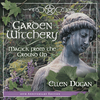The Real Scoop on Digging in the Dirt: Gardening Rituals for Growth

I always look forward to Spring; in fact, it never arrives quickly enough to suit me. After the long, cold Winter, I can hardly wait to throw open the windows, breathe fresh air, and feel the sunshine on my face. Just the thought of it makes me want to laugh and play and act like a child again. And...okay, I'll admit it: It makes me want to dig in the dirt.
As silly as that may sound coming from a grown woman, there's something both magical and therapeutic about plunging your hands into the soil. First of all, it reaffirms your link with the Earth and increases your capacity for walking between the worlds equally. It also provides a link to the collective consciousness of everyone who has ever tread that piece of ground. Just as important, though, it stabilizes the psyche and allows you to see everything in a new light—a brighter light—a light in which solutions are found, problems are solved, and fresh starts abound. And after the dormancy of Winter, that's something we can all use.
But what if you simply can't stand to get dirt under your fingernails? What then? Does that mean you'll have to forego all those wonderful Springtime benefits?
Of course not. Use gardening gloves if you have to, or try the meditation ritual below.
Earth Connection Meditation
Take a fertilizer stick or a few pennies to an outdoor area where there's plant-life, even if it's only a few blades of green grass. Sit on the ground in a comfortable position, and really look at the plants growing within your reach. Stroke their leaves, caress their stems, and let their fragrance fill the air. Then close your eyes, put your palms flat on the ground, kick back, and relax. Take a deep breath and inhale the fresh, green energy of the plant world and the fertile Earth. Hold your breath for a count of ten, and then exhale the metallic red energy of worries, stress, and aggravation. Let it sink into the Earth. Continue to inhale green and exhale red until you’re totally relaxed.
Eyes still closed, visualize your body changing. Watch as your legs sprout roots and sink into the ground. See them dig deeper and deeper into the safety of the moist, rich Earth. See your torso change, too, into a sturdy, well-developed plant stem. Finally, allow your arms, shoulders, neck, and head to transform, and watch them bud, sprout, leaf, and blossom beneath the warmth of the Sun.
Take a few moments to get used to your new form and life. Feel the breeze play through your leaves. Feel the sunshine warm your spirit. Let your roots travel through the Earth in search of water and nutrition. Bask in your new surroundings. Enjoy being a plant.
When you're comfortable with your new form, just "be" for a few minutes and feel the balance of the elements within you. Listen carefully to any messages that are channeled your way, and make a concerted effort to remember the information for future use.
When you're ready to come back to the physical realm, thank the spirits of the Earth and plant world for sharing their time and knowledge. Then stretch your arms, roll your neck, and shake off your leaves and blossoms. Twist your stem from side to side, and feel it become a torso again. Let your roots travel up through the ground until they reach the surface and dissolve into your feet. Wiggle your toes. Flex the muscles in your legs. Give yourself a good shake. Once your body feels normal again, bury the fertilizer stick or pennies as an offering, then stand up and walk away.
While the meditation above will certainly attune you to the energies of the Earth and its benefits, I like the hands-on approach—the one where you dig right in and work the soil with your fingers—much better. But that's probably because it gives me an excuse to plant something.
Herbs are good candidates for this. Why? The reason is two-fold. To begin with, herbs are common weeds. This means that they don't care about the condition of the soil. They don't care if you bother to talk to them or not. And since they handle the elements very well and get most of what they need from the Earth itself, they're not likely to keel over if you forget to water them once in a while. For the most part, they're self-sufficient little critters that grow strong and lush with or without our help—and that makes them the perfect choice for busy people.
The other reason is that we often use herbs in our magical practices. And there's just no sense in planting something unless we're going to enjoy it and put it to good use.
Whether you plant seeds, seedlings, or actual plants, or opt to garden indoors or out, is largely dependent upon weather and personal space. If it's still too chilly in your area to put something in the ground, you might want to start seeds indoors to transplant later. And regardless of the purpose for which you're sowing them—magical, culinary, or otherwise—blessing them first gives them a good start.
There's no need for an elaborate ritual in this case. Just place the seed packets in front of a green candle, place your hands over them and say something like:
Stretch and wake up, little ones
Feel the warmth of Shining Sun
Stir and shake off winter's cold
Sprout and thrive—grow tall and bold
Leave the seeds in front of the candle until the flame extinguishes itself. Then collect some peat pots, seed flats, and potting soil, and get on with the business of planting them.
If the danger of frost has passed and you're lucky enough to have a garden area or flower bed, then take some time to set out your seedlings or plants. Once you've handled the initial preparations with the trowel and garden claw, refine and aerate the soil by working it with your fingers. Crumble it in your hands and remove extraneous weed roots and debris. Inhale the rich aroma of fertility, invite it into your life, and thank the Earth for its gifts. Then scoop out enough soil to plant the seedlings.
At this point, you have a couple of options. You might use the planting, itself, as a simple ritual to embrace certain qualities that would provide you with a fresh start. If you lack patience, for example, you might bless one seedling with that attribute by planting it as you say:
I name you patience—grow in me
As you grow here. So mote it be.
Then plant the rest of the seedlings—imbuing each with a different characteristic—and know that as they grow under your care, so will those qualities grow within you.
If this ritual doesn't appeal to you, then just bestow a general blessing upon each plant as you place it in the ground. Something simple like the following works very well:
Grow, my friend, so very small
Grow until you're lush and tall.
One last thing: I highly recommend that you leave a small area of your garden spot untended and unplanted for the fey. (If you garden in pots, you may even want to fill a container with potting soil and water it occasionally.) While they'll certainly appreciate having their own space to plant as they please, the reason for this recommendation goes much deeper. It's been my experience that there's nothing worse than bored fey—left to their own devices, they often cause both personal and financial angst and aggravation—and this gives them something to do so they don't have time to meddle in human affairs. And meddle, they will, unless they're occupied.
While I won't bore you with my personal fey-related horror stories, suffice it to say that I now not only provide them with their own garden space, but take it one step further: I seal the deal by actually paying them to stay out of my business. Since the fey love shiny things, I just scatter a handful of dimes across the untended area. It's a small price to pay for peace of mind—and for the extra help I get in tending my own garden.

About Dorothy Morrison
Related Products


is subject to certain Terms and Conditions